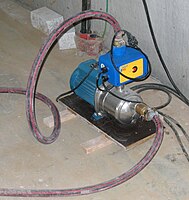
Photo from wikipedia
For the inverse designs of centrifugal and mixed-flow pump impellers, clarifying the generation process of secondary flows and putting forward corresponding suppression measures is an important approach to improve the… Click to show full abstract
For the inverse designs of centrifugal and mixed-flow pump impellers, clarifying the generation process of secondary flows and putting forward corresponding suppression measures is an important approach to improve the impeller performance. In this paper, to provide a better qualitative insight into the generation mechanism of secondary flows in the impeller, a simple kinematic equation is derived based on the ideal assumptions, which indicates that the potential rothalpy gradient (PRG) is the most important dynamic source that actively induces secondary vortical flows. Induced by the natural adverse PRG on the S1 and S2 stream surfaces, two typical secondary flows, H - S and P - S secondary flows, are clearly presented. To specially suppress these typical secondary flows, a general alternate loading technique (GALT) is proposed, aiming to adjust the real blade loading δp to control the PRG features. At the blade fore part, the δp on the hub streamline should be slowly increased to avoid breakneck growth of the potential rothalpy to reduce adverse streamwise PRG on the S2 streamsurface. At the blade middle part, the δp should be moderately decreased to reduce adverse streamwise PRG on the S1 streamsurface. At the blade aft part, the difference in the δp between the shroud and hub streamlines should be decreased faster to control the exit uniformity. By applying the GALT to the impeller designs of three typical pump types in hydraulic engineering, the organizational effect of the PRG on fundamental flow structures is proven. The GALT can effectively control the PRG distributions and suppress the secondary flows, thereby widening the pump’s high-efficiency zone, improving flow uniformity and suppressing pressure fluctuations. Compared with the current Z-G method and the ALT, the GALT can meet the requirements of “de-experience” better, thereby enabling the designers to obtain good products explicitly and quickly.
Journal Title: Science China Technological Sciences
Year Published: 2020
Link to full text (if available)
Share on Social Media: Sign Up to like & get
recommendations!